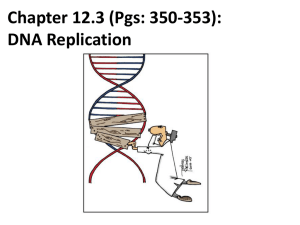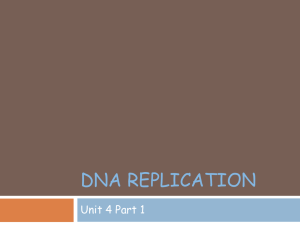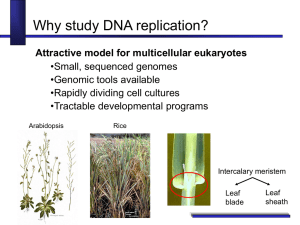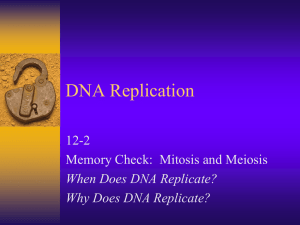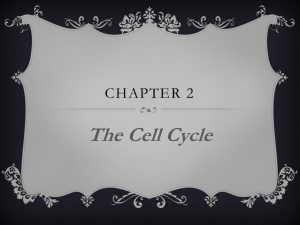Section E
advertisement
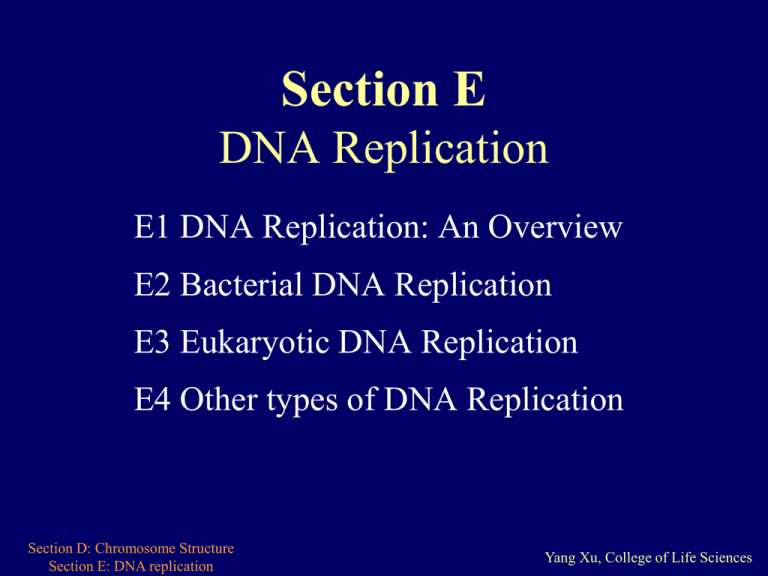
Section E DNA Replication E1 DNA Replication: An Overview E2 Bacterial DNA Replication E3 Eukaryotic DNA Replication E4 Other types of DNA Replication Section D: Chromosome Structure Section E: DNA replication Yang Xu, College of Life Sciences E1 DNA Replication: An Overview • • • • Semi-conservative mechanism Replicons, origins and termini Semi-discontinuous replication RNA priming Section D: Chromosome Structure Section E: DNA replication Yang Xu, College of Life Sciences Semi-conservative mechanism • This semi-conservative mechanism was demonstrated experimentally in 1958 by Meselson and Stahl N15 DNA 0 N14 1.0 2.0 3.0 4.0 0 + 2.0 0 + 4.0 S Section D: Chromosome Structure Section E: DNA replication Yang Xu, College of Life Sciences Replicons, origins and termini • Replication fork: The point at which separation of the double strands and synthesis of new DNA takes place. • Replcon: Any piece of DNA which replicates as a single unit is called a replicon. • Origin: The initiation of DNA replication within a replicon always occurs at a fixed point known as origin. • Terminus: Usually, two replication forks proceed bi-directionally away from the origin and the strands are copied as they separate until the terminus. Section D: Chromosome Structure Section E: DNA replication Yang Xu, College of Life Sciences Semi-discontinuous replication-I 3‘ 5‘ 3‘ 5‘ • Definitions: At each replication fork: – leading strand is synthesized as one continuous piece – lagging strand is synthesized discontinuously as short fragments in the reverse direction. They are joined by DNA ligase. • These lagging strand fragments (Okazaki fragments) are: – 1000-2000 nt long in prokaryotes; – and 100-200 nt long in eukaryotes. Section D: Chromosome Structure Section E: DNA replication Yang Xu, College of Life Sciences RNA priming • Finding fact: Close examination on Okazaki fragments has shown that the first few nucleotides at their 5‘-ends are ribo-nucleotides, as the first few nucleotides of the leading strand are ribonucleotides. • Conclusion: Hence, DNA synthesis is primed by RNA. These primers are removed and the resulting gaps filled with DNA before the fragments are joined. • Reason: The reason for initiating each piece of DNA with RNA appears to relate to the need for DNA replication to be of high fidelity (see F4). Section D: Chromosome Structure Section E: DNA replication Yang Xu, College of Life Sciences Synthesis of progeny strand in lagging DNA ppp primosome DNA polymerase III RNA as primer ppp DNA polymerase I DNA ligase Section D: Chromosome Structure Section E: DNA replication Yang Xu, College of Life Sciences E2 Bacterial DNA Replication • • • • Initiation Unwinding Elongation Termination and segregation Section D: Chromosome Structure Section E: DNA replication Yang Xu, College of Life Sciences Initiation-I Initiation model: the oriC-minichromosome: • Making: E. coli origin gene has been cloned into plasmids called oriC-minichromosome. • Function: It behaves like the E. coli chromosome. oriC contains four 9 bp binding sites for the initiator protein DnaA. Synthesis of DnaA is coupled to growth rate so that the initiation of replication is also coupled to growth rate. Prokaryotic chromosomes: • Initiation Feature: at high cellular growth rates the replication of the DNA can re-initiate a second round at the two new origins before the first round is completed. Section D: Chromosome Structure Section E: DNA replication Q Yang Xu, College of Life Sciences Initiation-II • DnaA protein : initiator – Once DnaA attain a critical level: – the DnaA proteins form a complex of 30-40 molecules, – each protein bounds to an ATP molecule, – around which the oriC DNA becomes wrapped in negatively supercoiling way (Fig. 2). – N-supercoiled facilitates melting of three 13 bp AT-rich sequences; they open to allow binding of DnaB. orC DNA DnaA AT-rich sequence Section D: Chromosome Structure Section E: DNA replication DnaB Yang Xu, College of Life Sciences Unwinding Factors related to unwinding • DnaB: the DNA helicases must travel along the template strands to open the double helix for copying; • A second DNA helicase: may bind to the other strand to assist unwinding besides DnaB. • Ssb: (Single Strand Binding protein) Binding of Ssb protein further promotes unwinding. • DNA gyrase, a type II topoisomerase: In a closed-circular DNA molecule, however, removal of helical turns at the replication fork leads to the positive supercoiling (see Topic C4). This positive supercoiling must be relaxed by the introduction of further negative supercoils by called DNA gyrase (see Topic C4). Section D: Chromosome Structure Section E: DNA replication Yang Xu, College of Life Sciences Elongation-I Proteins related to elongation: 1. Primosome: It is a mobile complex, which includes: DnaB helicase and Primase, synthesizes RNA primers every 1000-2000 nt on lagging strand. 2. DNA polymerase III holoenzyme: • Both leading and lagging strand primers are elongated by DNA polymerase III holoenzyme. This complex is a dimer, – One half synthesizes the leading strand; – The other synthesizes the lagging strand; – The two polymerases in a single complex ensures that both strands are synthesized at the same rate. • Same subunits in the both halves of the dimer contain: – an subunit, the actual polymerase; – an subunit, is a 3’5’ proofreading exonuclease; – a subunits clamp the polymerase to the DNA. • Different subunits: to synthesize short and long stretches of DNA on the lagging and leading strands, respectively. Section D: Chromosome Structure Section E: DNA replication Yang Xu, College of Life Sciences Elongation-II 3. DNA polymerase I: Once the lagging strand primers have been elongated by DNA polymerase III, they are removed and the gaps filled by DNA polymerase I, which has: – 5'3' exonuclease: removes the primers (Fig. 3); – 5'3' polymerase: fills the gaps with DNA by elongating the 3'-end of the adjacent Okazaki fragment; – 3'5' proofreading exonuclease: 4. DNA ligase: The final phosphodiester bond between the fragments is made by DNA ligase. The enzyme from E. coli uses the co-factor NAD+ as an unusual energy source. • Replisome: In vivo, the DNA helicases, the primosome and the DNA polymerase III holoenzyme dimer, are physically associated in a complex called replisome. Section D: Chromosome Structure Section E: DNA replication Yang Xu, College of Life Sciences Replisome Section D: Chromosome Structure Section E: DNA replication Yang Xu, College of Life Sciences Replisome model Section D: Chromosome Structure Section E: DNA replication Yang Xu, College of Life Sciences Termination and segregation • Termination: The two replication forks meet about 180 opposite oriC. – Terminator: in this region there are several terminator sites which arrest the movement of the forks by binding the tus gene product, which is an inhibitor of the DnaB helicase; – Hence, if one fork is delayed for some reason, they will still meet within the terminus. • Segregation: – Topoisomerase IV: Once replication is completed, the two daughter circles remain interlinked. They are unlinked by topoisomerase IV (a type II DNA topoisomerase); – They can be segregated into the two daughter cells by movement apart of their membrane attachment sites. Section D: Chromosome Structure Section E: DNA replication Yang Xu, College of Life Sciences Segregation Section D: Chromosome Structure Section E: DNA replication Yang Xu, College of Life Sciences E3 Eukaryotic DNA Replication • Origins and initiation • Replication forks • Telomere replication Section D: Chromosome Structure Section E: DNA replication Yang Xu, College of Life Sciences Origins and initiation-I • Individual origin structure: – Size: only 11 bp – Structure: the sequence is [A/T]TTTAT[A/G]TTT[A/T], • The initiation system for eukaryotic replication includes: – multiple copies of this origin are required for efficiency; – the origin recognition complex (ORC) which permits opening of the origins for copying; – ORC is activated by CDKs. • Licensing factor: – It is a protein which is absolutely required for initiation and inactivated after use, – It can only enter into the nucleus when the nuclear envelope dissolves at mitosis, thus preventing premature re-initiation. Section D: Chromosome Structure Section E: DNA replication Yang Xu, College of Life Sciences Origins and initiation-II • Features of eukaryotic initiation: at defined times in S-phase each replicon can only initiate once per cell cycle tandem arrays of about 20-50 replicons after. • Initiation Order in S-phase comprise: – the first part is in euchromatin (which includes transcriptionally active DNA); – the second parts are within heterochromatin – the last are for centromeric and telomeric. • ARSs (Autonomously replicating sequences): – Individual yeast replication origins have been cloned into prokaryotic plasmids. – Since the origins allow these plasmids to replicate in yeast (a eukaryote) they are termed ARSs. – Eukaryotic origins + prokaryotic plasmids eukaryote Section D: Chromosome Structure Section E: DNA replication Yang Xu, College of Life Sciences Replication forks-I 135bp • DNA between the forks and nucleosomes – Free state: Before copying, the DNA must be unwound from the nucleosomes at the replication forks. – Bending state: After the fork has passed, new nucleosomes are assembled. • Proteins related to replication: – DNA helicases are required to separate strands; – RP-A (Replication protein A) is for binding ssDNA; – DNA polymerases (three types) are used for elongation. Section D: Chromosome Structure Section E: DNA replication Yang Xu, College of Life Sciences Replication forks-II The three polymerases • DNA polymerase : Function: synthesizes RNA primers by its primase domain; initiates and elongates the leading strands and each lagging strand fragment by its DNA polymerase domain; • DNA polymerase : Function: replaces DNA polymerase on the leading strand; proofreads the leading strand; synthesizes long DNA. • DNA polymerase : Function: replaces DNA polymerase on the lagging strand; proofreads the lagging strand. Section D: Chromosome Structure Section E: DNA replication Yang Xu, College of Life Sciences Telomere Structure • The problem of dsDNA ends: The ends of linear chromosomes cannot be fully replicated by semi-discontinuous. Thus, genetic information could be lost from the DNA. • Telomere structure: To overcome this, the ends of eukaryotic chromosomes (telomeres) consist of hundreds of copies of a simple, noninformational repeat sequence (e.g. TTAGGG in humans) with the 3‘-end overhanging (突出 于) the 5'-end. 3'-AATCCCAATCCC-5' 5'-TTAGGGTTAGGG (TTAGGG)n TTAGGG-3' Fig. 3. Human telomeric DNA (n=several hundred) Section D: Chromosome Structure Section E: DNA replication Yang Xu, College of Life Sciences Telomere replication • Telomerase structure: Telomerase contains a short RNA molecule: one part is a 150 bp RNA and the other part is a complementary sequence to this repeat. • Telomere replication: 1. Elongation : This RNA acts as a template for the addition polymerization; 2. Translocation: Then telomerase moves and leaves a 3'overhang, which is the template of next polymerization. • Special function (biological clock): Telomerase activity is repressed in somatic cells, resulting in a gradual shortening of the telomere with each cell generation. As this shortening reaches informational DNA, the cells die. Section D: Chromosome Structure Section E: DNA replication Yang Xu, College of Life Sciences G –T2G4---- TTGGGGT TGGG TTGGGGTTG C – A2C4---aaaAACCCCAACuuac--aaaAACCCCAACuuac--5’ 5’ telomerasetelomerase 3’ 3’ Ploymerization Section D: Chromosome Structure Section E: DNA replication Translocation Ploymerization Translocation Yang Xu, College of Life Sciences That’s all for Section E Section D: Chromosome Structure Section E: DNA replication Yang Xu, College of Life Sciences

